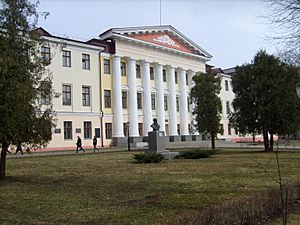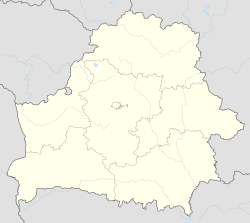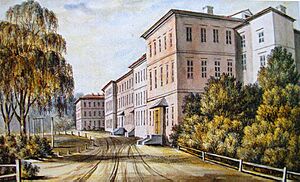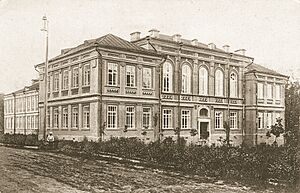Horki facts for kids
Quick facts for kids
Horki
|
|||
|---|---|---|---|

Belarusian Agriculture Academy
|
|||
|
|||
| Country | Belarus | ||
| Region | Mogilev Region | ||
| District | Horki District | ||
| First mentioned | 1544 | ||
| Area | |||
| • Total | 22.1 km2 (8.5 sq mi) | ||
| Elevation | 191 m (627 ft) | ||
| Population
(2024)
|
|||
| • Total | 28,961 | ||
| • Density | 1,310.5/km2 (3,394/sq mi) | ||
| Time zone | UTC+3 (MSK) | ||
| Postal code |
213410
|
||
| Area code(s) | +375 2233 | ||
| License plate | 6 | ||
| Website | Official website: http://gorki.gov.by/ | ||
Horki or Gorki (Belarusian: Горкі, IPA: [ˈɣorkʲi]; Russian: Горки) is a town in the Mogilev Region of Belarus. It is the main town of the Horki District. In 2009, about 32,777 people lived there. By 2024, the population was around 28,961.
Contents
History of Horki Town
Early Beginnings of Horki
Horki was first written about in 1544. It was mentioned in "The Lithuanian Chronicles" as a small village. The first known owner was Prince Drucki-Horski. Later, in 1584, the powerful Sapieha family took ownership of Horki.
Kazimierz Leon Sapieha built a new Catholic church in Horki. He did this to honor his father, Lew Sapieha. In the 1600s, Horki became the center of the Hory-Horki estate. Until the 1800s, it was often called Hory.
Life in Horki in the 17th Century
Horki was a busy place, holding three markets and annual fairs. In 1683, it had 510 houses. There were also two special areas called “Kazimirovskaya Slaboda” and “Zarechye.” Horki was part of the Orsza County. This county was in the Vitebsk Voivodeship, which was part of the Grand Duchy of Lithuania. This whole area belonged to the Polish–Lithuanian Commonwealth.
During the Great Northern War, a very important person visited Horki. Tsar Peter I of Russia stayed in the town from July 9 to August 16, 1708.
Horki Joins the Russian Empire
In 1772, Horki became part of the Russian Empire. This happened during the First Partition of Poland, when parts of Poland were divided among other countries. On October 23, 1772, the Mogilev Province was split into four smaller provinces. Horki and the areas around it became part of the Orsha province. Later, it moved to the Orsha district, and then the Kopyssky district.
Growth of Agricultural Education
A big change happened in 1840 when the Horki Agricultural School opened. Just eight years later, in 1848, it became the Horki Agricultural Institute. From then on, Horki became a key place for learning about farming in what is now Belarus.
The opening of these schools helped Horki grow. For example, an iron factory started in 1859. A post office opened in 1840, and a pharmacy also opened that year. A weather station began working in 1841.
Becoming a Town
On December 26, 1861, the government officially changed Horki from a village to a town.
During the January Uprising in 1863, there was a battle in Horki. Polish fighters won against Russian soldiers on May 6, 1863. In 1864, the Agricultural Institute moved to Saint Petersburg. Only the agricultural and taxation schools stayed in Horki.
Horki's City Council and Coat of Arms
People living in Horki could choose to stay in their current social class or move to a lower middle class. If they changed, they would give their land to the government. A Horki City Council was created to manage town services and legal matters.
In 1867, Horki got its own special symbol, called a coat of arms. It showed three hills, with the middle one being the tallest. Wheat plants grew from the tops of the hills, showing that farming was important to the town. The top part of the coat of arms also had the symbol of the Mogilev province.
Horki During World War II
During World War II, Horki was controlled by German forces. This period lasted from July 12, 1941, until June 26, 1944.
Today, the official symbol and flag of Horki were approved in 2006. This was done by a special order from the President of Belarus.
Climate
| Climate data for Horki (1991–2020, extremes 1841–present) | |||||||||||||
|---|---|---|---|---|---|---|---|---|---|---|---|---|---|
| Month | Jan | Feb | Mar | Apr | May | Jun | Jul | Aug | Sep | Oct | Nov | Dec | Year |
| Record high °C (°F) | 9.0 (48.2) |
11.1 (52.0) |
22.6 (72.7) |
27.6 (81.7) |
30.9 (87.6) |
34.5 (94.1) |
35.3 (95.5) |
38.7 (101.7) |
29.9 (85.8) |
24.5 (76.1) |
13.8 (56.8) |
10.1 (50.2) |
38.7 (101.7) |
| Mean daily maximum °C (°F) | −3.1 (26.4) |
−2.4 (27.7) |
3.1 (37.6) |
12.2 (54.0) |
18.5 (65.3) |
22.0 (71.6) |
24.1 (75.4) |
23.1 (73.6) |
17.1 (62.8) |
9.6 (49.3) |
2.3 (36.1) |
−1.8 (28.8) |
10.4 (50.7) |
| Daily mean °C (°F) | −5.5 (22.1) |
−5.3 (22.5) |
−0.8 (30.6) |
6.8 (44.2) |
12.8 (55.0) |
16.5 (61.7) |
18.5 (65.3) |
17.2 (63.0) |
11.8 (53.2) |
5.8 (42.4) |
0.2 (32.4) |
−3.8 (25.2) |
6.2 (43.1) |
| Mean daily minimum °C (°F) | −8.1 (17.4) |
−8.2 (17.2) |
−4.5 (23.9) |
2.0 (35.6) |
7.2 (45.0) |
10.9 (51.6) |
13.2 (55.8) |
12.0 (53.6) |
7.2 (45.0) |
2.5 (36.5) |
−1.8 (28.8) |
−5.9 (21.4) |
2.2 (36.0) |
| Record low °C (°F) | −39.5 (−39.1) |
−36.7 (−34.1) |
−33.2 (−27.8) |
−17.7 (0.1) |
−4.4 (24.1) |
−2.1 (28.2) |
3.5 (38.3) |
0.7 (33.3) |
−6.9 (19.6) |
−13.8 (7.2) |
−24.4 (−11.9) |
−34.1 (−29.4) |
−39.5 (−39.1) |
| Average precipitation mm (inches) | 36.5 (1.44) |
32.8 (1.29) |
36.5 (1.44) |
36.2 (1.43) |
62.6 (2.46) |
71.0 (2.80) |
83.7 (3.30) |
72.8 (2.87) |
51.4 (2.02) |
60.5 (2.38) |
46.3 (1.82) |
38.0 (1.50) |
628.3 (24.75) |
| Source: Pogoda.ru.net | |||||||||||||
Notable People from Horki
Many interesting people have connections to Horki:
- Raphael Kalinowski (1835–1907): He was a Polish friar, a teacher, and an engineer. He studied at the Horki Agricultural Institute and is now considered a Catholic saint.
- Lev Razgon (1908–1999): A journalist and writer. He was a prisoner in the Gulag (a system of labor camps) and later worked to protect human rights.
- Sergei Tikhanovsky (born 1978): He is an activist who works for democracy. Some groups, like Amnesty International, consider him a political prisoner.
See also
 In Spanish: Gorki (Bielorrusia) para niños
In Spanish: Gorki (Bielorrusia) para niños






